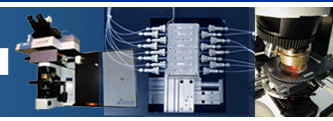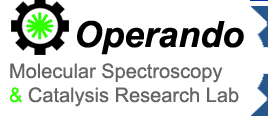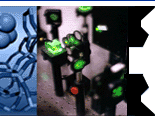for real-time molecular spectroscopic analysis of
catalytic active sites and surface reaction intermediates and simultaneous micro GC-MS for rapid online analysis of the reactor products.
The current combinatorial reactor system employs an
8-channel parallel microreactor for simultaneously
obtaining molecular level spectroscopic and reaction kinetic data. The present reactor system is currently being further expanded to a 100-channel microreactor system and to operate at higher pressures. The
8-channel microreactor system is mounted on a
programmable X-Y motorized stage that allows spatial positioning and timing of the spectroscopic data
acquisition (spatial and temporal resolution). The optical microscope is equipped with an autofocus feature to take full advantage of the confocal optical microscope. In summary, the combinatorial operando spectroscopy-reactor system is fully automated once the catalysts have been loaded into the reactor channels.
|




